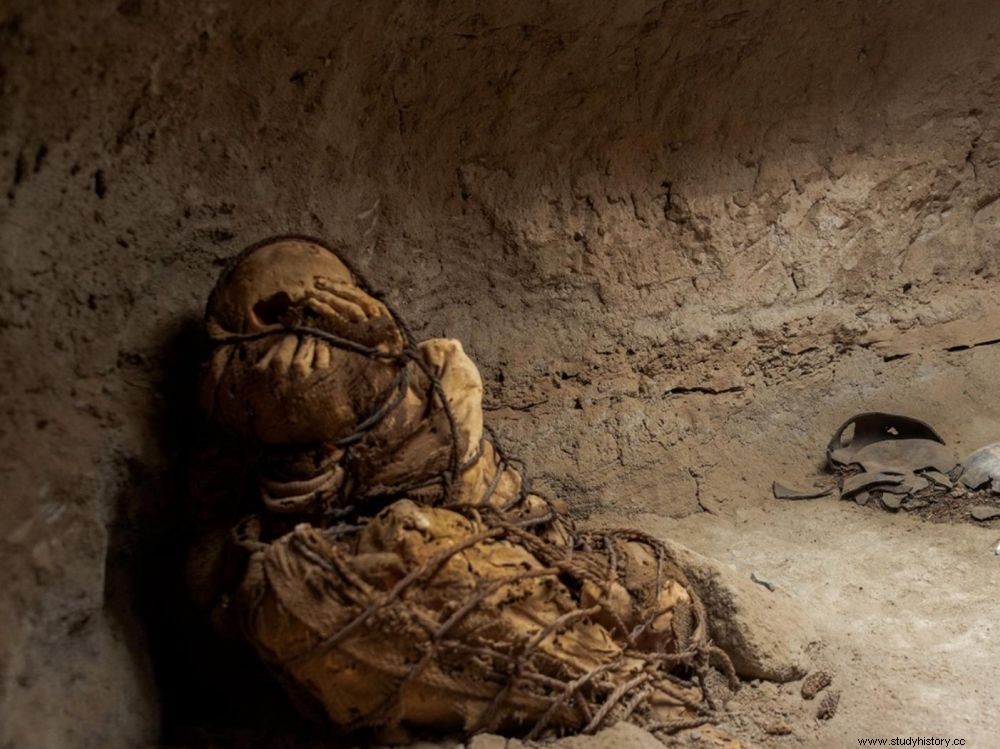A mummy over 800 years old in perfect condition has been discovered near Lima in Peru.

Pre-Inca mummy recently discovered in an underground burial structure at the Cajamarquilla site, on the outskirts of Lima, Peru.
A broad smile floods the faces of the two researchers responsible for the excavations of the archaeological complex of Cajamarquilla, near Huachipa, east of Lima, Peru. For the past few days, they have been making headlines in the international press since their discovery of an intact pre-Inca mummy whose age could date back between 800 and 1200 years. A godsend for these two specialists rather accustomed to the damage produced by huaqueros , the countless grave robbers who roam the region. Although the site is the second largest architectural complex built in adobe (adobe) on the central coast of Peru, with an area of 140 hectares, undisturbed areas remain rare.
A mummified body that appears in the dark...
But luck has smiled on Pieter Van Dalen Luna and Yomira Huaman Santillan, from the University Mayor of San Marcos -UNMSM (Lima) since they and their students discovered this burial at the entrance concealed by a platform. "The mummy was inside an oval underground burial structure, which was accessed by taking a staircase of seven steps" , Yomira Huaman Santillan told the Peruvian daily La Republica . In the half-light, the naturally mummified body of one of the former inhabitants of this city appeared, which already sheltered, well before the arrival of the Incas in the 16th th century, several thousand people.

Archaeologists from the Universidad Nacional Mayor de San Marcos (UNMSM) during the discovery of the mummy in the archaeological complex of Cajarmarquilla, in Lurigancho near Huachipa, east of Lima. ©Pieter Van Dalen Luna et alii, UNMSM.
The mummy is enclosed in a mesh of woven plant fibers
"The typical body position (seated, knees bent over torso and arms around knees or pulled up to chest or neck height) spreads from what scholars refer to as the Middle Horizon - that is - i.e. the 8 th and 9 e centuries AD and touches all the cultures of the central Andes, without exception, up to the Incas" , specifies the archaeologist specializing in Peru, Peter Eeckhout, of the Free University of Brussels (UBL), joined by Sciences et Avenir.
Enclosed in a mesh of braided plant fibers, the mummy was buried according to a funerary model closer to that of the populations of the mountainous areas of ancient Peru than those of the coast. "Without going to the more remote regions of the Andean mountains of the Amazon region, where these types of line burials are common, this remains could have come from the sierras of the Lima Valley" , continues Peter Eeckhout. Isotopic analyzes are also planned to determine the origin of the deceased, whose sex has not yet been specified.
"This discovery shows us above all that this architectural complex was occupied by both coastal and mountain peoples and that the location of Cajamarquilla in the Huaycloro ravine was undoubtedly strategic for trade between these different communities" , added Pieter Van Dalen Luna. Archaeologists hope that this discovery on the outskirts of the Peruvian capital in the district of Lurigancho - Chosica, and the heritage it contains on the right bank of the middle valley of the Rímac River, will now be protected by the authorities.
Ceramics, remains of offerings and cut stone tools also accompanied the deceased on his last journey. Radiocarbon dates planned in a laboratory at the University of Krakow (Poland) should make it possible to assign a more precise chronology to this discovery, probably linked to the pre-Inca Chacila culture.
